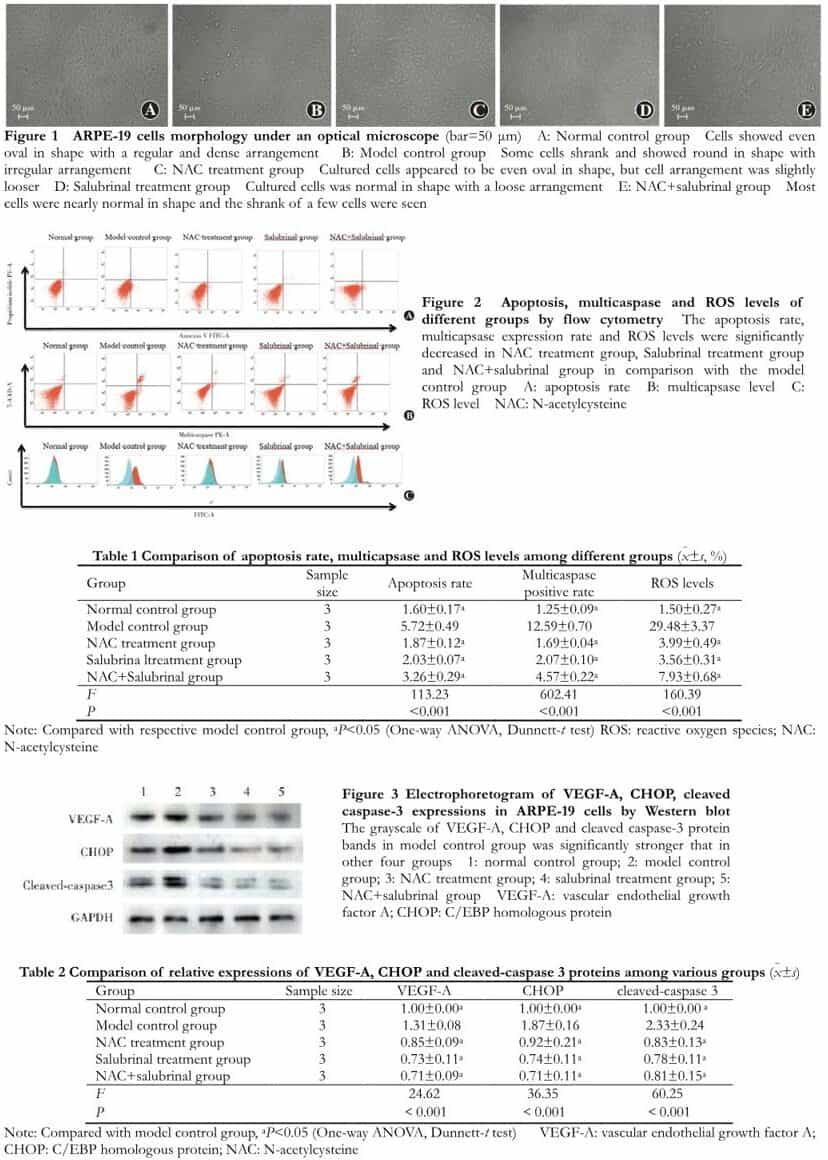Abstract [Download PDF] [Read Full Text]
Objective
To observe the effect of the antioxidant N-acetylcysteine (NAC) and selective endoplasmic reticulum stress response inhibitor salubrinal on the apoptosis of retinal pigment epithelial cells induced by all-trans-retinoic acid (ATRA).
Methods
Human ARPE-19 cell line was used as the experimental cell line, and was divided into normal control group cultured with complete medium, model control group cultured with complete medium containing 10 μmol/L ATRA, NAC treatment group cultured with complete medium containing 10 μmol/L ATRA+ 5 mmol/L NAC, salubrinal group cultured with complete medium containing 10 μmol/L ATRA+ 40 μmol/L salubrinal, NAC+ salubrinal group cultured with complete medium containing 10 μmol/L ATRA+ 5 mmol/L NAC+ 40 μmol/L salubrinal.After 24-hour culture, apoptosis rate, multicaspase level and reactive oxygen species (ROS) level of ARPE-19 cells were detected by flow cytometry.The expressions of vascular endothelial growth factor A (VEGF-A), C/EBP-homologous protein (CHOP), cleaved-caspase 3 in cells were detected by Western blot.
Results
There were significant differences in the apoptosis rate, multicaspase and ROS levels among the five groups (F=113.23, 602.41, 160.39; all at P<0.001). The apoptosis rate, multicaspase and ROS levels of normal control group, NAC treatment group, salubrinal group and NAC+ salubrinal group were significantly lower than those of model control group (all at P<0.05). There were significant differences in the expression levels of VEGF-A, CHOP and cleaved-caspase 3 among the five groups (F=24.62, 36.35, 60.25; all at P<0.001). The protein expression levels of VEGF-A, CHOP and cleaved-caspase 3 of normal control group, NAC treatment group, salubrinal group and NAC+ salubrinal group were significantly lower than those of model control group (all at P<0.05).
Conclusions
ATRA can induce RPE cells to produce oxidative stress and endoplasmic reticulum stress injury, which leads to apoptosis.NAC and salubrinal can effectively reduce the RPE cell apoptosis by inhibiting stress response.
Key words:
Figures&Tables

Contributor Information
State Key Laboratory of Ophthalmology, Zhongshan Ophthalmic Center, Sun Yat-sen University, Guangdong Provincial Key Laboratory of Ophthalmology and Visual Science, Guangzhou 510060, China
State Key Laboratory of Ophthalmology, Zhongshan Ophthalmic Center, Sun Yat-sen University, Guangdong Provincial Key Laboratory of Ophthalmology and Visual Science, Guangzhou 510060, China
State Key Laboratory of Ophthalmology, Zhongshan Ophthalmic Center, Sun Yat-sen University, Guangdong Provincial Key Laboratory of Ophthalmology and Visual Science, Guangzhou 510060, China